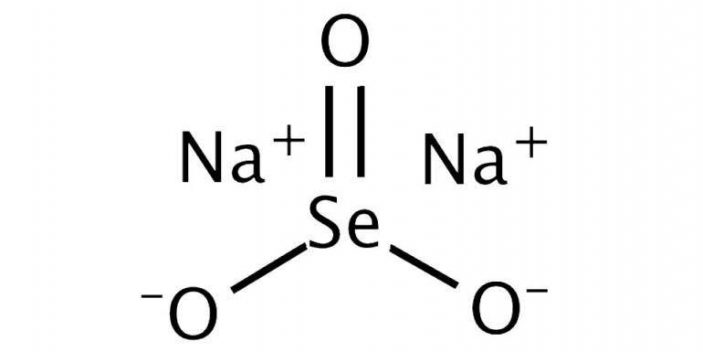Selenium (Se) is one of the necessary micro-minerals that cats require. Whereas there are foods that have this mineral, commercial cat food manufacturers often add selenium in various forms including the use of sodium selenite or sodium selenate or by use of organic forms such as selenomethionine and selenium yeast.
Sodium selenite (Na2SeO3) has been in many cat foods for several decades. However, of late, there are concerns about its safety for these animals. Is it safe for toxic?
Here is how it looks like.

Is sodium selenite safe in cat food?
A study on “selenium status in adult cats and dogs fed high levels of dietary inorganic and organic selenium” published in Journal of Animals Science notes that selenite is “less efficiently absorbed compared with selenomethionine because of its passive mechanism of transport through the brush border membrane of the gastrointestinal tract.”
Secondly, the issue of selenium being non-toxic is also supported by the book, ‘Selenium Medicine: And the Rising Tide of Mercury’ by Dr. Mark Sircus.
However, this does not discuss anything on the safety selenite but only notes that it is less efficiently absorbed.
A second study shows that cats can maintain more than 10 times the amount of selenium that humans or rats can maintain without any clinical signs of poisoning. Again, the emphasis here is a high level of selenium.
This is attributed to their high efficiency in its excretion through their urine and since cats only store a very small amount of this mineral in their liver.
Absorption and utilization
Once a cat’s body has absorbed selenite (by diffusion), the red blood cells take it up, converts it to selenide and afterward release it to blood plasma where it will be bound to albumin and transported to the liver for utilization.
Perhaps the strain on sodium selenite on “vital organs, increasing possible disease affecting blood, muscles and liver” that Pet Prince notes is based on the need to convert it to selenide.
In support, one study (Spallholz & Raftery, 1987) on the effect of Selenium yeast (Se-yeast) vs sodium selenite shows some toxicity in the later and not the former. This could indicate it could be potentially harmful. No studies have been conducted on its safety on feline to verify this observation.
The opinion expressed by Best Cat Food on why not go for the more efficiently absorbed (Se-yeast instead Na2SeO3 is based on cost and not on why it is harmful or toxic.
While cost is an important consideration in making any pet food, safety is not necessarily a factor of cost.
What do experts think?
Why responding to why The Honest Kitchen Whole Grain Chicken Recipe Dehydrated Dog Food has sodium selenite, a response by Chewy.com notes that it addresses both the sodium and selenium requirements while Se-yeast wouldn’t address the sodium requirement.
Furthermore, it is noted that toxicity does arise from several minerals if they are given in quantities beyond recommended maximum amounts and some dogs have shown sensitivities to yeasts.
Finally, still on the same response by Chewy, it is noted that Se-yeast has not been yet to be approved by AAFCO to be used in cat foods, a reality that even critics of selenite such as Truth about Pet Food acknowledge.
While responding to a question on Justanswer.com, Dr. B., a cat veterinarian notes that whereas there might be concerns, the amount added to cat food is little and these pets are able to effectively regulate Se. You should only avoid diets that are high in selenite.
Conclusion
More research needs to be done specifically on the effect on Na2SeO3 on cats before discrediting any foods that do not contain it.
Many people are simply going for cat food without sodium selenite without concrete reasons why they are the ideal ones.
By only basing Material Safety Data Sheet (MSDS) to conclude something is toxic alone is not realistic. Even pure oxygen is toxic.
References
- Spallholz, I. E. and Raftery, A. 1987 Nutritional, chemical toxicological evaluation of high selenium yeast. In the International Symposium of Se in Biology and Medicine 516- 52

Hi , usually Selenium is a mineral considered essential for thyroid function in humans, I’ve tried several times to eat Brazil Nuts or take supplements, I always end up in the same situation, my eyes burn and skin is affected, although some other people does take Selenium daily without any effect, some like me end up with an excess, thus maybe the studies on pets (and humans) are not complete yet, as of now I won’t be giving food that has this supplement to my cats.